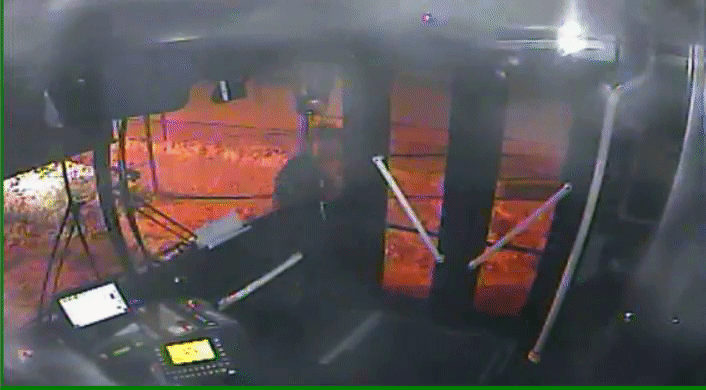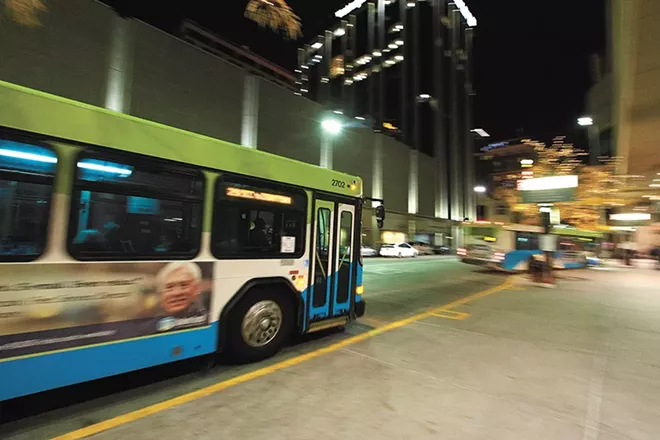A sudden assault against a Spokane Transit Authority bus driver last week has the bus drivers union asking for plexiglass shields that drivers could lower if they feel unsafe.
On Friday, March 10, as an experienced driver was training a colleague, a departing passenger sucker-punched the driver.
"The next thing [the driver] knew he as looking up at the ceiling of the bus," says Thomas Leighty, president of Amalgamated Transit Union Local 1015. "He was bleeding."
Leighty says the driver was wondering about what would have happened if he had been at the wheel when he was punched instead of his trainee. Would he have come to a stop? Would he have careened through the intersection?
This and other recent incidents have caused the union to join other drivers nationally in demanding STA install protective driver barriers.
The barriers, manufactured by New Flyer, are already used in New York City and Washington D.C. Last year, Metro Vancouver in Canada — which had 110 assaults against drivers in 2015 — began testing the barriers as well.
At times, even minor frustrations can set passengers off.
"Most of the stuff we've had that people get upset over is a fare dispute," Leighty says. "They’re having a bad day. [The driver] didn’t tell them hello.’"
Drivers being assaulted outright by passengers is relatively rare, he says, but it happens. Leighty references a time a few years ago when a passenger had taken a bottle of his own urine onto the bus.
"They open the bottle and splashed the driver with their urine," Leighty says. "The driver was pretty upset about that. That goes from zero to 10 on the
In 2009, a passenger held a knife to a driver's throat and told him to take him somewhere to go fishing. He also struck the driver with an ice-scraper, cutting his upper lip. The passenger would not release the driver until the police arrived and took him into custody.
More common, he says, are threats. An angry passenger will approach the driver and raise up their
"Like, 'Oh, yeah, you better be scared'," Leighty says. "We have drivers that will tell you, 'I had this guy come up to me, and tell me that 'I better not see you outside of this bus.'"
A plexiglass shield wouldn't be able to stop verbal threats from being issued. But Leighty says it could stop water or trash from being thrown at the driver. It would protect the driver from being spit on.
"Some drivers, they'll never want to use it," Leighty says. "Other drivers will want to have it up at all times."
Leighty says he's meeting with STA officials today to discuss the proposal. Installing the shields would cost about $5,000 per bus.
The STA administration, however, says that they first considered the barriers when they were being introduced nationally a few years ago, and declined to pursue them further.
"We never felt like we foster the same environment in Spokane," says STA spokesman Brandon
Not only are assaults against drivers extremely rare, only about 3 percent of riders surveyed say they feel unsafe on the STA bus.
Not only that, he says, but the shields create a number of logistical issues. They don't completely seal in or protect the drivers,
"It creates a climate problem for the drivers in the little space," he says. The shields also inhibit the ability of drivers to quickly respond to an incident, like a medical emergency, in other parts of the bus.
Still, some moments can be frightening for STA drivers, even if it doesn't result in violence.
Leighty cites a road-rage incident in December when a motorist — accusing
"He’s yelling and screaming at the driver," Leighty says. Then the motorist comes around to the passenger-side door. The driver keeps the door closed, but the furious motorist punches the glass.
"It just fractures," Leighty says. "With one hit, he broke the glass with his bare hand."
The driver waits as the motorist screams and
"I'm shaking," the driver says on the recording. "I've never had anything happen like that."

STA camera footage
An angry motorist pounds on the glass of the door of an STA bus in December, shattering the glass.
"I can’t reiterate to my drivers enough: A $1.50 fare isn’t worth your life," Leighty says.
Leighty is also urging the legislature to take measures to increase penalties for assaults against bus drivers.
Amid all this, however, Leighty stresses that passengers don't have anything to fear from their fellow bus riders. He says he's been riding the bus for years and hasn't had an issue.
"The only time we have passenger incidents is if they know each other. If they’ve been fighting with each other [previously]," Leighty says. "I don’t think passengers should really be worried about violence in the bus."

